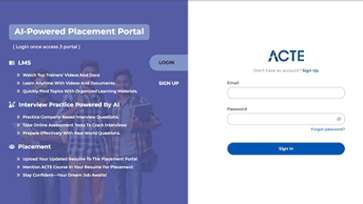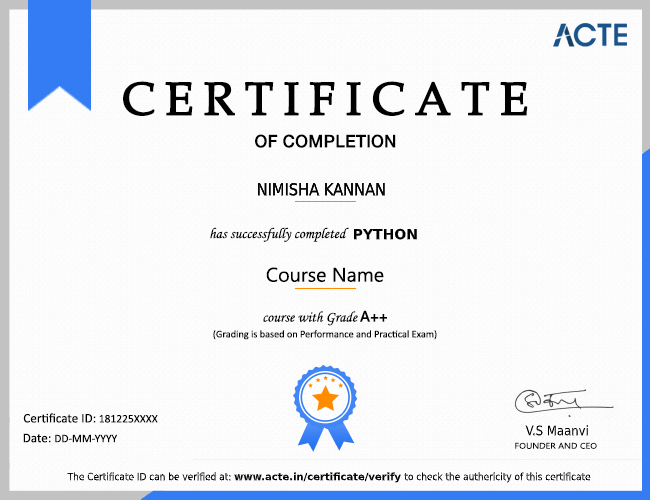Robotic Process Automation is one of the fastest growing technologies for improving real-time business operations and processes. RPA (Robotic Process Automation) allows automating business processes using software robots. This Robotic Process Automation training at ACTE will provide the students with a complete understanding of workflow, data manipulation, bots, plugins, exception handling, logging and code management.Start Learning with us ACTE Robotic Process Automation (RPA) Classroom & Online Training Course.
The growth of the industry and widespread adoption of RPA will drive job growth as well. Many types of jobs are available in RPA, including developer, project manager, business analyst, solution architect, and consultant. This is fact, going to be the future and most important thing in the coming years. RPA in the future is going to incorporate the following things: Incorporating AI for advanced decision-making and inferencing.
Meanwhile, there are so many good opportunities are been involved in the future scope of RPA can be observed in the field of data entry and data rekeying jobs. These tasks could easily automated with RPA. The various repetitive tasks such as formatting, data assembling or anything, which requires a series of steps, that can easily carried out with the help of RPA. RPA will definitely become the next revolution in technology and you will surely find thousands of jobs opening every year. There are more than 5 million jobs awaiting you, right now.
However, robotic process automation (RPA) anticipated evolving and soaring over the forecast period. The modern enterprises need robotic process automation for faster implementation, execution, and scaling. Technological advancements have triggered businesses to overcome new challenges aimed to cope with changing consumer demand and requirements. In the recent past, the adoption of robotic process automation has captured the attention of many SMEs and large enterprises. This can be able to attribute to RPA’s ability to deliver seamless operation coupled with significant value addition from the resources.
We are happy and proud to say that we have strong relationship with over 700+ small, mid-sized and MNCs. Many of these companies have openings in Robotics. Moreover, we have a very active placement cell that provides 100% placement assistance to our students. The cell also contributes by training students in mock interviews and discussions even after the course completion.
Absolutely it’s an future field where, According to Forrester Research (Nov 2015), up to 9% of the global workforce will be threatened by RPA software in the near future. The change is coming, and it is up to process improvement professionals to prepare for this disruption by properly educating their corporations on the do’s and don’ts of RPA. Robotic process automation (RPA) been heralded as the next big thing in process management. Google Trends reports show that the last 2 years have seen a peak in interest in these technologies.
The Difference between Robotic Process Automation and Artificial Intelligence. RPA is a software robot that mimics human actions, whereas AI is the simulation of human intelligence by machines. RPA is a technology that uses specific set of rules and algorithm and based on automated a task. Mean While AI is focused more on doing a human-level task, RPA is practically a software that reduces human efforts — it is about saving the business and white-collar workers' time.
Robotics Process Automation (RPA) allows organizations to automate task just as a human being was doing them across application and systems. ... RPA does not require the development of code, nor does it require direct access to the code or database of the applications. Initially, coding skills are not required. However, if you want to learn more of RPA, at least one programming language would be required to extend the existing RPA functionality. There are no prerequisites for Automation Anywhere. No coding is required..... Automation Anywhere empowers organizations to automate the processes that has been executed by the humans.
Our courseware is designed to give a hands-on approach to the students in Robotics Automation. The course is made up of theoretical classes that teach the basics of each module followed by high-intensity practical sessions reflecting the current challenges and needs of the industry that will demand the students’ time and commitment.
In 2020, RPA is going to claim its place as a central platform for other enterprise automation tools. RPA has been around for the last few years and has advanced considerably. It can manage any types of tasks that are repetitive and predictable. It frees up the resources to focus on tasks that require creativity, decision-making and judgement. As per Forrester, RPA Market will reach $2.9B by 2021.
The future certainly belongs to RPA, and workforces around the world are investing heavily in this efficient technology to fast-track organizational efficiency, effectiveness and profitability. Nonetheless, global robotic process automation has come a long way since 2016. At the time, RPA software purchases amounted to $73 million. This increased to $113 million in 2017, $153 million in 2018, and $192 million in 2019. In 2020, HFS Research estimates that this figure will rise to $232 million and by 2021 to $272 million. These projections indicate that there is strong growth in RPA adoption in the global market. RPA services have increased rapidly since 2016, rising from $198 million, to $630 million in 2019. By 2021, that figure is expected to rise to $952 million. Experts roundly agree that RPA is the future of IT automation
The growth of the industry and widespread adoption of RPA will drive job growth as well. Many types of jobs are available in RPA, including developer, project manager, business analyst, solution architect, and consultant. People are often concerned about robotic process automation taking jobs away from real people. But a lot of companies who need manual data entry already aren’t hiring local employees for those tasks. They’re outsourcing their data entry overseas. Since the bots would be managed/hosted here in the USA, using RPA actually repatriates jobs.
The Future of RPA
Time to get out our crystal balls again: Where is RPA headed? Our unique position in the market, powering business processes of more than 600 global enterprise customers, BPO providers and shared services organizations, gives us an exclusive lens into RPA’s path forward. Here are three trends we see on the horizon:
RPA architecture must be able to scale with the enterprise, securely.
Plenty of companies have launched a proof of concept (POC), but scaling across enterprises requires not just business inputs like a roadmap and Center of Excellence (COE), but also an enterprise-class RPA architecture that can cost-effectively scale across use cases, business units, divisions and global offices.
Consider security, compliance, total cost of ownership and the roadmap of your RPA vendor. In the near future, an on-demand cloud architecture will be important.
Bot-building will become self-service.
As far back as 2011, there was a gap between what applications can do and the unmet needs of the business user in The Consumerization of App Development. This gap is largely due to lack of IT resource availability and justification of expensive programming resources. In the new digital workforce, a generation of “Apptepreneurs” and “Citizen Developers” will arise, essentially democratizing what was formerly an IT role.
In RPA, there could be a future where business users—not just business analysts—will be able to build their own robots. This ability will again transform the value of RPA: Imagine your own workweek and some of the boring, manual and painful things you have to do. Wouldn’t it be great if a robot were doing that grunt work for you?
AI technology and RPA will solve more business problems.
Tech media and some vendor marketing treat artificial intelligence like it’s a magic black box, but consider what happens when you ask Google, Alexa or Siri a question. Sometimes they’re laughably unintelligent, completely missing the point and unable to pivot. Recently, Facebook’s algorithm flagged an excerpt from the U.S. Declaration of Independence as “hate speech” and took the post down, later apologizing and explaining that intent and context are complex issues.
The first generation of customer service chatbots that replaced humans completely typically failed in this regard. While AI involves intelligent “thinking” work, the outputs are only as good as the inputs and what is learned by the algorithm from the inputs. In the case of the chatbots, those tech early adopters quickly found that people asked all kinds of questions they haven’t anticipated, which is why many AI deployments today are used to augment humans, not replace them entirely.
Now and in the future, the combination of AI + RPA is about picking the right cognitive moment: Where am I going to apply this technology? Artificial intelligence has been used for years and will be increasingly utilized to transform the workforce of the future.
Scope of RPA:
The scope of RPA is infinite and huge. In fact, it is anticipated that the RPA will be the future of IT automation. If someone wants to build his or her career in RPA this particular field will automatically grow their career views. The field of Artificial Intelligence is one of the prospects and it would include the innovative level of decision making and job implications. Also, the RPA would show its great prospects in the banking domain, where the robots will going to be utilized to practically perform all the calculations and transactions. It will also show its consequences in more leading-edge technology in the area such as automobiles and aircraft manufacturing. It is highly anticipated that regular as well as online courses are going to barb up extremely in the next approaching years. Most of the RPA tools such as RPA Blue Prism, UiPath, automation anywhere are already being used in the business. The candidate who wants to build their career in the field of RPA can learn any of this tool to implement the RPA in the future.
In this context of vendors looking for differentiators and ways to add more value, the future of RPA should see an increase in the range of the robots’ functionalities:
- Integrating more intelligence, while always making RPA more accessible and actionable by the users
- Climbing the value chain to more cognitive: adding to RPA (which only “does”), the functions to “think & learn” and “interact” with the environment
- Moving, in the longer term, to Artificial Intelligence (AI), including the ability to autonomously drive other robots
- Connection of RPA with data analytics systems (big data) to analyze actual data and predict future trends (e.g. share price trends): The robot is able to understand, think, decide and act (e.g. sell or buy shares) on the basis of the outcome of the analysis
- Combination of Natural Language Processing (NLP) and cognitive: Virtual assistants (e.g. chatbots) able to interact with internal or external clients or operators, to facilitate their work. Chatbots will enable a better / faster adoption of RPA, making it more friendly / interactive
- Combination of Natural Language Processing (NLP) and Machine Learning: Enabling the understanding of unstructured data received via text or pictures (E.g. unstructured data from incoming invoices using different formats). The robot is able to learn by itself through repetition, build patterns and understand new formats based on what it has learnt by experience
- Robot configuration assistants (a next step in machine learning): The robot will be able to learn by itself; solely through observing a human executing tasks on a computer, identify the tasks repeated regularly (e.g. daily, weekly), propose to robotize them by itself, and then configure them. When considering the investment in adopting RPA, the largest amount is always the configuration cost, and this functionality will help reduce it drastically
- Integration with Artificial Intelligence (AI) robots (e.g. Watson, AlphaGo): Given the current state of technology, talking about AI has to be focused upon a specific narrow topic. Let us take the example of the finance function: finding mistakes in finance compliance audits, and summarizing information out of reports spanning a thousand pages. More and more RPA vendors are working on such integration.































